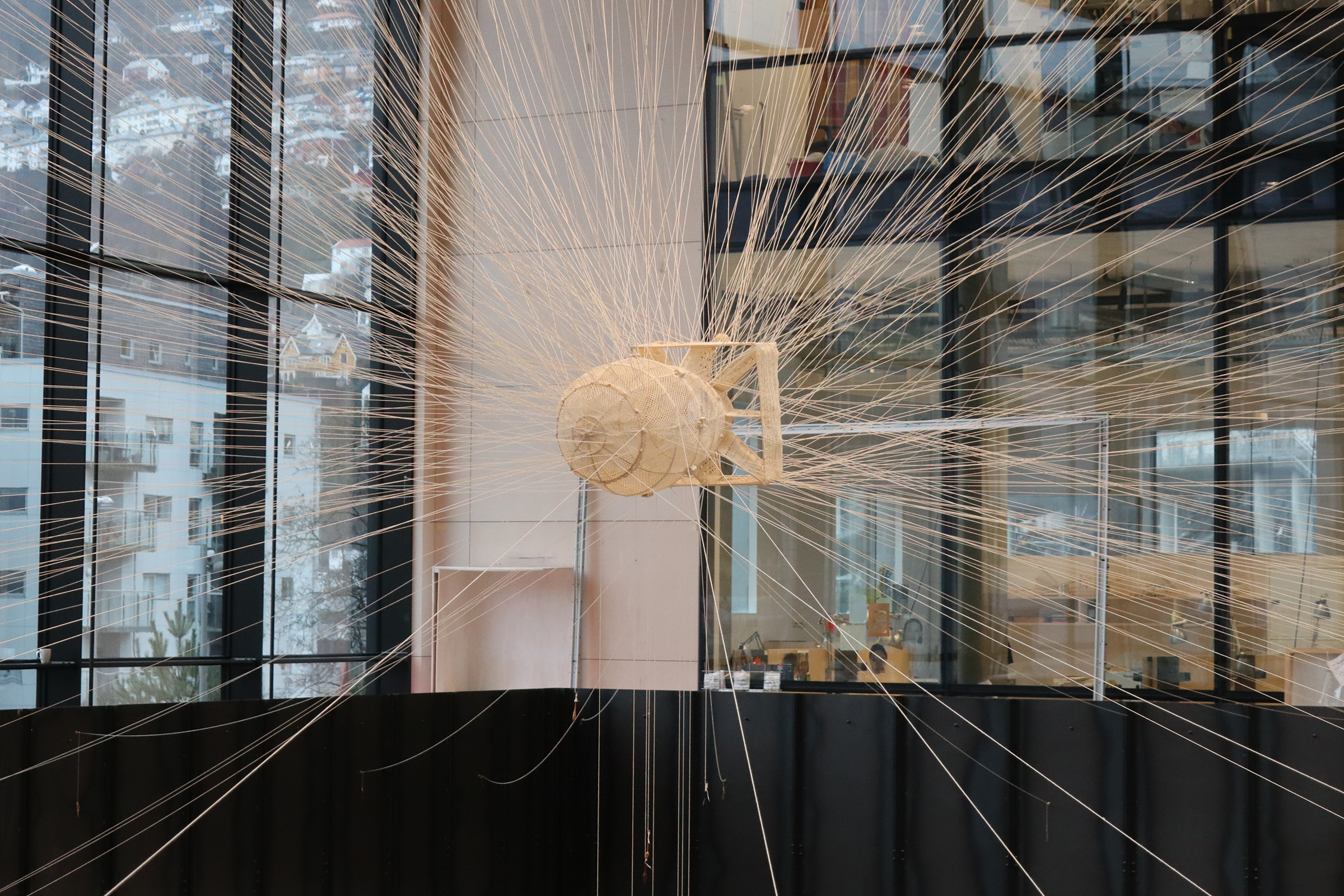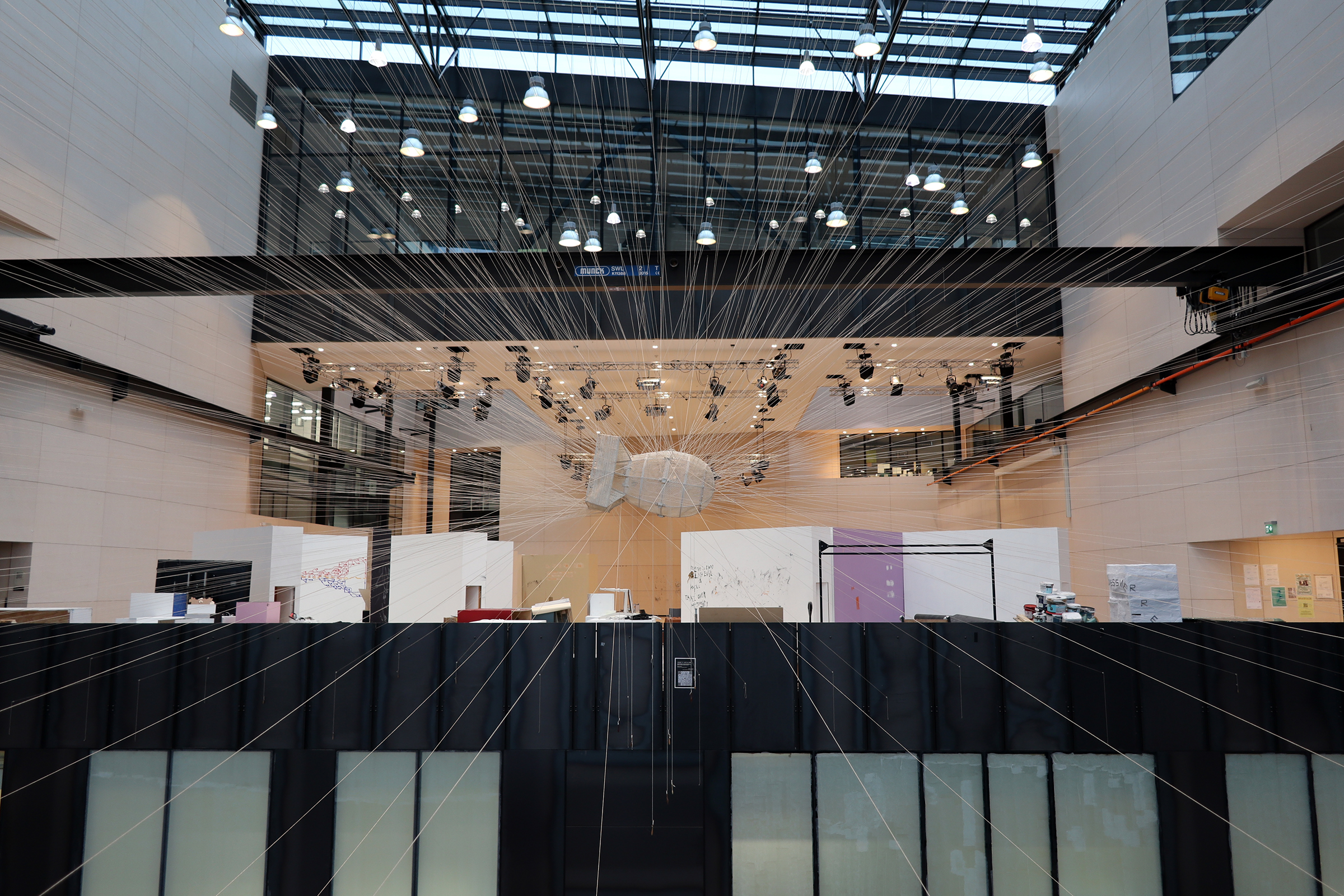
In the framework of the exhibition at La Kunsthalle, I was able to produce one new work, Fat Man 3D, exhibited in the entrance hall of KMD in Bergen, Norway, as part of my final presentation.
Fat Man 3D is a copy of the atomic bomb, code name Fat Man, that was dropped on Nagasaki, Japan, on 9 August 1945. The work laces together the interlinked histories of cotton and uranium in an immersive and explosive installation. Most of the uranium used in the first atom bombs produced in the framework of the Manhattan Project came from the Shinkolobwe mine in Katanga, in what was then the Belgian Congo. It was processed in America’s southern states and shipped to Antwerp in Belgium by the Belgian businessman Edgar Sengier, the director of the Union Minière du Haute-Katanga, an Anglo-Belgian mining company operating in the Congo’s copper belt between 1906 and 1966. A similar route was followed in the past by cotton. Enslaved people transported from the Kingdom of Kongo in central Africa and elsewhere planted and picked cotton in America’s southern states, whence it was shipped to the cotton mills of the United Kingdom and also to Belgium and the rest of western Europe to be used in the bobbin lace industry. That is not the only tragic link between the braided histories of cotton and uranium. When the Second World War broke out, Japan was one of the world’s major cotton producers and traders, almost surpassing Britain. Dropping Little Boy and Fat Man (the code names of the second and third atomic bombs made by the US as part of the same Manhattan Project) on Hiroshima and Nagasaki heralded a definite end to the cotton empire of Japan.
Ethnologist Florence Fröhlig and historian of science, technology, and the environment Tatiana Kaspersky wrote: “By lending visibility to all the different people and institutions involved, directly or indirectly, consciously or unconsciously, Fat Man 3D reminds us that the production of the bomb was the result of a collective venture. From one stage of the process to the next, so many lives were dedicated to carrying out this work, whether in the extraction of uranium to the production of plutonium, the decisions made in ministers’ cabinets and army headquarters, or the development and assembly of the bomb in scientific laboratories. The spindles, still attached to the spools of thread, are intertwined in a crazy plot to develop a machine with which to destroy human lives. Is our collective responsibility sewn with white thread? Since the creation of nuclear weapons, life – our life, dependent on other lives – has been hanging by a thread. Will we be able to learn from the destruction of the past to preserve the fragile fabric of our intertwined lives?”
For the final presentation of my Ph.D., the work is shown in one of the few spaces in Bergen that can host this complex work: the huge entrance hall of KMD. The work is a singular example of the complex creation process involving different people and different stages of research, as discussed in the previous section about art-making. Although the very labor-intensive installation was mainly produced with the help of Rita Van Cotthem, an expert in 3D bobbin lace art, the whole process, from start to finish, looks rather like a “collective venture,” as mentioned by Fröhlig and Kaspersky. It is a scaffolding process, not just because of the installation requirements for the work itself or because of the multiple steps (by multiple people) that need to be taken to be able to realize it, but because of the necessary deconstruction and reconstruction of the historical references to a specific series of events that need to have taken place for the work to exist. As an artist, I walk the entangled ropes of history that help me navigate and support my thinking. At the same time, these pre-existing spiderwebs lure and inspire me to add new treads and make certain connections stronger or (a)new. Art making and exhibition-making are thus, for me, much more a collective practice, a Latourian “composition” of sorts, a means to simultaneously de-compose artificial ruptures in the fabric of history and re-compose different prospects of the past in order to imagine alternative futures.
